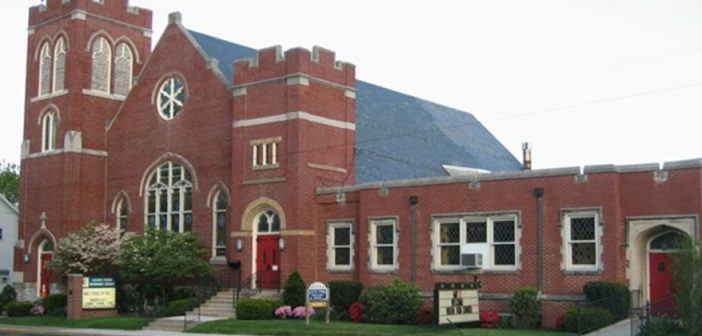Lewis A. Parks, author of Small on Purpose, describes how smaller congregations can easily squander their last resources for ministry attempting to keep up with the mounting demands of an aging facility. He says such churches must decide for the people of God rather than their present building, before it’s too late.
I came to Calvary United Methodist, Lemoyne, Pennsylvania, in my favorite pastoral role, as one who rescues. Calvary was once a vibrant 700-member church with two full-time ordained pastors, a staff of eight, and an average weekly worship attendance of 338 (1963). Calvary was “big church” and had the building to prove it — a 20,500 square-foot Romanesque Revival fortress with a replacement value of $5,280,000.
Through the decades of mainline decline, Calvary declined, too, but at a gentle rate. Leaders and members made necessary adjustments. They learned to live within their means. Yet at the same time the 110-year-old building continued to exert its claims at a rate that was becoming irritating and eventually alarming.
Sometimes the elephant in the room is the room! We need to keep talking about the mounting and impossible demands of the building.
In my first year at Calvary we had to address two critical risk recommendations from a recent insurance inspection: jersey barriers for a parking lot near the nursery school ($3,000) and a ventilation hood for the 20-burner gas oven ($21,000). Year two the air conditioning unit gave out ($20,000) and the dreary lighted sign in front demanded replacement ($5,000). Year three we filled and patched the sinkholes in the parking lot ($11,000) but held off on the resurfacing ($30,000) that would have completed the job. In year four we rescued the red cross on the State Street tower ($6,000) and replaced some of the very old gas pipes that were beginning to leak ($4,000) in the boiler room. One of the trustees reminded me the boiler pipes and cast-iron radiators have lasted much longer than we have a right to ask (estimated cost $42,000). The organist reminded me that the “leaking expression shades” need repair soon ($29,000) and a hole in the “blower reservoir” needs repair now ($4,000). “Should I start playing hymns on the piano?”
At one point in year four I tried to take us on the offensive. I convinced the leadership to hire an architect and draw up plans for a welcome center. The renovated restrooms, infant care room, and coffee serving area would be near the entrance of the sanctuary. It would surely give us the $64,000 makeover we needed to hold the younger visitors. The congregation was cautiously positive. Some, but not enough, pledged financial support. In the end, I was the one to pull the plug. I could not in good conscience put them in a debt that would likely hasten death.
So here we are: loving our tabernacle, temple, synagogue, house church, but not able to afford it. We cannot improve items of décor, comfort, or convenience. We are waiting for the next large ticket item that will empty our savings or drastically change our lifestyle, such as giving up the organ for the piano or closing off part of the building.
It is an unfinished story with a probable finish. And the finish is that Calvary church will do what dozens of formerly large churches have done in the city where we are located and thousands have done across the country. They will gather on the deck of the Titanic to sing “Nearer my God to Thee” as it goes down. That is, they will exhaust their last spiritual gifts for ministry, their last impulses to form surrogate family, their last bit of confidence that they have a message the community needs, exhaust them for the lesser cause of keeping their building open as their numbers dwindle. Last one out, turn off the lights!
As their pastoral leader, my strong desire is that Calvary would avoid that probable finish. They deserve better than the pall of fatalism that settles over a disappearing congregation in an oversized building. To that end, I have asked the leaders and congregation to join me in three actions:
Accept that we are a healthy small church rather than a sick larger church. This is not easy for anyone who remembers the glory days nor for the pastor who wants to be the hero who brings them back; but it is the critical first step to survival. If we seek new constituents to breathe life into a larger church, our efforts will be desperate and will come across that way. Come fill our seats, our offering plate, our fading programs! On the other hand, if we rest in our strengths as a small church — and there are many —– our invitations can be spontaneous. We are not recruiting; we have something good to give away to those who may be receptive.
Face the reality of an oversized building. Sometimes the elephant in the room is the room! We need to keep talking about the mounting and impossible demands of the building. For nearly 50 years in ministry I have been waiting for the anonymous widow to surprise everyone by leaving the church a million dollars at her death. It hasn’t happened yet! I count the rich widow’s gift among the many fantasies that distract God’s people from taking necessary action. Frank talk about limiting and even dangerous conditions in the building forces the congregation to ask after its core identity.
Before it’s too late, decide for the people of God over the present building. We’re not there yet at Calvary. If we abandon 700 Market Street now, we lose precious worship ambience and the capacity for two vital ministries. But that day may be coming. I try to remember that any given congregation has outlived at least two buildings, sometime nearly a dozen. Every church knows what it is to pick up stakes and move on. Calvary was started as a prayer meeting in a lawyer’s office across the street from its present location. It is not that buildings don’t matter; they do for all the reasons specified above. But when it comes down to choosing between a vital congregation in dynamic equilibrium or squandering the resources of that congregation to maintain an oversized building, the God of Abraham (Gen 12:1-3) should win out every time.
This article is excerpted from Small on Purpose: Life in a Significant Church (Abingdon Press, 2017) by Lewis A. Parks. Used by Permission. The book is available at Cokesbury and Amazon.
Related Resources
- Eleven Characteristics of Effective Smaller Churches by David R. Ray
- A New Way to View Vitality in Smaller Congregations by Lewis A. Parks
- Small Church as Surrogate Family by Lewis A. Parks







